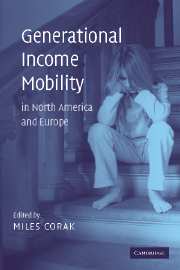Book contents
- Frontmatter
- Contents
- List of figures
- List of tables
- List of contributors
- Preface
- 1 Generational income mobility in North America and Europe: an introduction
- 2 A model of intergenerational mobility variation over time and place
- 3 Equal opportunity and intergenerational mobility: going beyond intergenerational income transition matrices
- 4 Intergenerational mobility for whom? The experience of high- and low-earning sons in international perspective
- 5 What do trends in the intergenerational economic mobility of sons and daughters in the United States mean?
- 6 Changes in intergenerational mobility in Britain
- 7 Intergenerational mobility in Britain: new evidence from the British Household Panel Survey
- 8 Non-linear patterns of intergenerational mobility in Germany and the United States
- 9 Family structure and labor market success: the influence of siblings and birth order on the earnings of young adults in Norway, Finland, and Sweden
- 10 New evidence on the intergenerational correlation in welfare participation
- 11 Intergenerational influences on the receipt of unemployment insurance in Canada and Sweden
- 12 Unequal opportunities and the mechanisms of social inheritance
- Index
- References
1 - Generational income mobility in North America and Europe: an introduction
Published online by Cambridge University Press: 22 September 2009
- Frontmatter
- Contents
- List of figures
- List of tables
- List of contributors
- Preface
- 1 Generational income mobility in North America and Europe: an introduction
- 2 A model of intergenerational mobility variation over time and place
- 3 Equal opportunity and intergenerational mobility: going beyond intergenerational income transition matrices
- 4 Intergenerational mobility for whom? The experience of high- and low-earning sons in international perspective
- 5 What do trends in the intergenerational economic mobility of sons and daughters in the United States mean?
- 6 Changes in intergenerational mobility in Britain
- 7 Intergenerational mobility in Britain: new evidence from the British Household Panel Survey
- 8 Non-linear patterns of intergenerational mobility in Germany and the United States
- 9 Family structure and labor market success: the influence of siblings and birth order on the earnings of young adults in Norway, Finland, and Sweden
- 10 New evidence on the intergenerational correlation in welfare participation
- 11 Intergenerational influences on the receipt of unemployment insurance in Canada and Sweden
- 12 Unequal opportunities and the mechanisms of social inheritance
- Index
- References
Summary
During the 1990s, a number of countries in both North America and Europe set explicit targets for the reduction of child poverty, including the United Kingdom, Ireland, and Canada. In the United Kingdom, the pledge, announced in 1999, was to eliminate child poverty in a generation; in Canada, the ambition, made clear a decade earlier, was to seek to do the same by the year 2000. And even in countries less explicit about their goals, reducing child poverty has been an important public policy concern. This, for example, is as true in the United States, where child poverty rates have historically been among the highest relative to other rich countries, as it is in Sweden, where they have been among the lowest. Clearly, this issue has a strong resonance in public policy discourse, and reflects a growing concern over the welfare of all children regardless of their place in the income distribution. But why should societies care more about children than any other group? One possible reason is that children have certain rights as citizens, but are dependent upon others for the defense of their rights. This may certainly be the case, but another reason – one often explicitly made by advocates – is instrumental: children should be thought of as investments in the future. This argument suggests that in the long run the productivity of the economy and the well-being of all citizens would be higher if the well-being of children were improved, and in particular if child poverty were reduced.
- Type
- Chapter
- Information
- Publisher: Cambridge University PressPrint publication year: 2004
References
- 13
- Cited by

